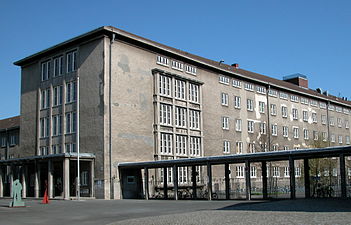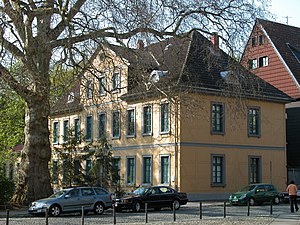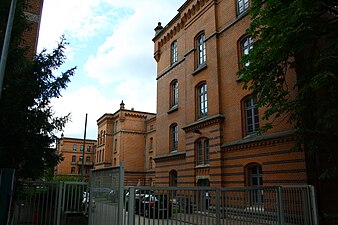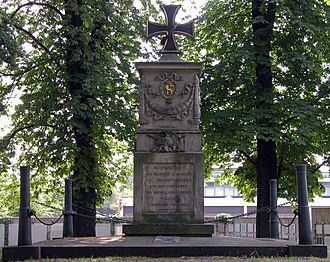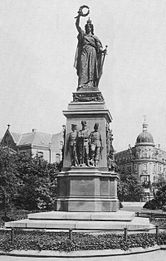History of the garrison town of Braunschweig
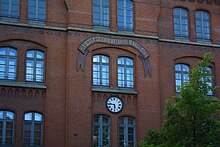
The history of the city of Braunschweig as a garrison town began in 1671 and ended in October 2003 with the dissolution of the last two barracks, the Roselies and Heinrich-der-Löwe barracks. This ended the history of the garrison town of Braunschweig after 332 years .
overview
The city of Braunschweig had been a garrison town since 1671, after the submission by the Braunschweig dukes, until the last federal military units withdrew in 2003. The soldiers were initially quartered in town houses. However, as this often led to complaints from the residents, the first barracks were built in the city in the second half of the 18th century. The military not only served to fight external enemies, but also - depending on the epoch - exercised an order and repression function in town and country.
After 1955, the Bundeswehr moved into the city. Their presence in Braunschweig ended in 2003.
Garrison town from 1671
The era leading up to the founding of the empire from 1671 to 1871
The city of Braunschweig and the city of Wolfenbüttel were the only two cities in the former Principality of Braunschweig-Wolfenbüttel with fortifications . After their siege and submission by the dukes, Braunschweig was elevated to a princely garrison in 1671 and the location of the princely army , the strength of which varied over the years. At that time there was one company of life guards on horseback and one on foot, as well as two companies of the cavalry regiment, the infantry regiments “von Stauffen”, “von Schönberg” and “von der Brüggen” and the artillery . The stationed units were always composed of several regiments. Even in times of peace there was always a certain contingent of Braunschweig soldiers under arms in the city.
The Aegidienkaserne, built in 1756, was the first in Braunschweig. It was built on the site of the former Aegidien monastery courtyard ( Lessingplatz since 1853 ). Three more barracks were built by 1825: Augusttor barracks (1806), Burg barracks (1808) and Magnitor barracks (cavalry barracks, 1825). The conditions in the barracks were inadequate until 1843. There have been reports that, for example, the castle barracks had been described as dilapidated since 1820 and an impending collapse in 1832 was only inadequately countered by makeshift repairs. The barracks buildings were poorly insulated and the rooms and dormitories were often overcrowded and the air circulation was additionally impaired in winter by windows draped with ceilings. Water penetrated the upper floors of the Aegidien barracks even when it rained, making it impossible to use the premises. In 1837 it was therefore decided to build a new infantry barracks, in which there were partially separate bedrooms and living rooms for soldiers. In 1841 the first battalion moved there. In addition to the barracks, there was a military hospital and a separate garrison school for the soldiers . This had emerged from the St. Aegidi school, but was not available to the team ranks, as it was forbidden for them to marry or start a family. Abbot Franz August Christian Westphal, director of the orphanage and garrison school and cathedral preacher, died on February 20, 1847 . In 1852, the two free schools and the two community schools as well as the orphanage and garrison school were merged and placed under a joint municipal school board and school director.
At the beginning of the 19th century, shooting ranges were set up at the quarry at Nussberg for the training of the soldiers of the garrison. These were used until 1919. In honor of Major General Johann Elias Olfermann (1776-1822), who commanded the Braunschweig troops after the Duke's death and led them in the Battle of Quatre-Bras, a memorial column was erected in 1832 not far from the shooting range.
In 1816 the Military Administration Commission was created, which was responsible for the military administration. From 1826 these tasks were taken over by the Ducal War College. He was responsible for the safekeeping of the war chest, the administration of the barracks, food and supplies as well as the armory and the military hospital. In terms of hierarchy, the respective duke was the commander-in-chief of the Brunswick military, the commandant of the active corps was subordinate to him; from 1848 this was the brigade commander. The garrison service was organized by the city commanders.
| Period | Rank | Surname |
|---|---|---|
| 1813 to 1821 | Lieutenant General | Johann Heinrich Carl von Bernewitz |
| 1821 to 1830 | Lieutenant General | Johann Carl Moll |
| 1830 to 1835 | Lieutenant General | Friedrich August von Herzberg |
| 1835 to 1847 | Lieutenant General | * Ernst von Schrader |
| 1847 to 1851 | Major general | Heinrich August Christian von Brandenstein |
| 1851 to 1855 | Lieutenant General | Johann Heinrich Ernst Gustav von Normann |
| 1855 to 1867 | Lieutenant General | Alexander Leopold von Erichsen |
There were latent tensions between the soldiers and parts of the Braunschweig population, especially the lower class, which could lead to violent conflicts in times of crisis or on special occasions.
First World War 1914 to 1918
When the First World War broke out in 1914 , it also affected the Duchy of Braunschweig. On August 4th of this year, the Berlin parliamentary group of the SPD approved the “ war credits ” as part of the so-called “ Burgfriedens ”. Since Braunschweig was a garrison town and Infantry Regiment No. 92 and Hussar Regiment No. 17 were stationed there, the city was not unaffected by these political events. The general mobilization on August 1st met with approval and a unit of the Braunschweig hussars moved out of the barracks to the applause of the population. On July 31, Duke Ernst August had already handed over his government to the Duchess Victoria Luise in order to serve as an officer in the Prussian army and to go to war. With the mobilization, the reservists moved into the Braunschweig barracks. The Braunschweig SPD, which was rather skeptical of the war, published critical articles in its magazine “ Volksfreund ”. The initial enthusiasm for the war was quickly dampened when reports of deaths of Brunswick soldiers in the city began to pile up in the first few months of the war. As a result, hospitals, such as the Schloss-Lazarett, were set up in the city and women were trained in medical care. Armaments production was given a high priority within the city, the companies were converted to war production and many women were employed in these factories because there was a shortage of workers. Companies that manufactured canned food or machines benefited in particular. As a result of this restructuring, there was soon a shortage of food because not enough farm workers were available for the harvest. Bread and vegetables had to be rationed and discontent among the urban population increased.
When the news of the demand for the abdication of Kaiser Wilhelm II finally reached Braunschweig in October 1918 , there were also demonstrations here in November on Leonhardplatz. On November 6th, the prison was stormed and the police headquarters and the train station were occupied by the demonstrators. Two days later, a “ workers and soldiers council ” was elected and the Duke of Braunschweig-Wolfenbüttel abdicated on the same day. This ended the rule of the Guelphs in Braunschweig on November 8, 1918. Subsequently, the Workers 'and Soldiers' Council proclaimed the "Socialist Republic of Braunschweig".
Weimar Republic 1920 to 1933
Due to the Versailles Treaty , Germany was only allowed to maintain land forces with a maximum of 100,000 men. After the end of the First World War, the Reichswehr Infantry Regiment 20 was initially stationed in the city. On January 1, 1921, the 17th Infantry Regiment of the Reichswehr was formed from associations of the transitional army , which had its regimental staff in Braunschweig. The following stations in the state of Braunschweig are documented for the end of the 1920s:
- Infantry barracks, Braunschweig, Humboldtstr. 30-33
- The oldest in Braunschweig
- Headquarters of the 17th Infantry Regiment
- I. (Braunschw.) Battalion of the 17th Infantry Regiment with the 1st to 3rd Company, 4th Machine Gun Company
- Military administrative authorities
- Hussar barracks, Braunschweig, Altewiekring 20
- 2nd and 4th company as well as 13th (Braunschweig) mine thrower company of the 1st battalion
- Braunschweig, Gliesmaroder Strasse 29
- On-site hospital in Braunschweig and on-site doctor
- Artillery barracks, Wolfenbüttel, Lindener Strasse 16
- The oldest location in Wolfenbüttel
- 7th battery of the 6th (Prussian) Artillery Regiment
- 9th (Kw.) Battery of the 6th (Prussian) Artillery Regiment
- Medical team Wolfenbüttel of the medical department 6
National Socialism 1933 to 1945
With the seizure of power on January 30, 1933, the independence of the states of the German Reich was also lost in 1934 due to the law on the reconstruction of the Reich . An imperial reform should serve to subdivide the entire empire into roughly equally large imperial districts, for this purpose the Free State of Braunschweig was to be united with the southern part of the Prussian province of Hanover . However, this plan was not implemented. In order not to lose his own position of power, the Prime Minister of the Free State of Braunschweig Dietrich Klagges decided to campaign for a Reichsgau Ostfalen with a capital Braunschweig. To this end, he had the city expanded into a model city of National Socialism. This also included the expansion of the military facilities and the construction of large barracks. From 1935 the garrison was mainly determined by artillery units and the staff of the 31st Infantry Division .
- Troops, facilities and external commands
Most of these barracks were built between 1936 and 1938. The facilities for the troops of the army were largely in the south and east of the city. For example, in 1935 the “Observation Department 31” moved to the Schill barracks and two departments of the “Artillery Regiment 67” moved to the Heinrich-der-Löwe-Kaserne and the Hindenburg-Kaserne, in 1936 the “Intelligence Department 31” moved to the Siegfried Barracks, and in 1938 the “Panzerabwehrabteilung 31 "In the Leutnant Müller barracks and the" Parachute Infantry Battalion 1 "in the Roselies barracks, which was named after the Belgian town of Roselies . In addition, the "Medical Department 31" quartered in the former military hospital on Gliesmaroder Straße. The command center with the division headquarters, the site administration and an army casino were located in Schillstrasse.
The front troops during the war included the 31st Infantry Division, the Infantry Regiment No. 17, the Anti-Tank Department 31, the Artillery Regiments 55 and 67 as well as the Flak Group Braunschweig and the Luftnachrichten Regiment 2, the 1st SS Totenkopf Hunting Brigade and the SS Guard Battalion Braunschweig. There were also medical teams, army technical schools and replacement or reserve regiments and the Braunschweig Aviation School . The Wehrmacht Commandantur, the Wehrbezirkskommando (military substitute district Hanover) and the Luftkreiskommando VII with the Luftwaffe Group Command 2 and the 4th Flieger Division were also stationed in Braunschweig. Other important facilities were the Heeres-Munitionsanstalten Grasleben and apprenticeship , an air tank and ammunition depot and the external commandos of the Neuengamme camps ( Büssing and Schilldenkmal camps , SS riding school , steelworks and troop management) and Buchenwald ( SS Junker School ).
The buildings for the air force were located in the north and west. There was the “reconnaissance flight school” in Broitzem , from 1938 the “pilot school” in the Tannenberg barracks and a training facility for the “Luftnachrichtenregiment 2” in the hussar barracks. The command center for these facilities and at the same time the headquarters of the "Air Force Group 2" was the "Air Fleet Command 2" on Grünewaldstrasse. In addition, officers' own housing complexes, such as the Bastholz or Lindenbergsiedlung and in Mascheroder Holz, were built in some cases . There were also residential areas close to the barracks in the city center, for example the “Fliegerviertel” (Grünewaldstrasse).
- Images of garrison buildings
Former Luftflottenkommando 2
since 1989 IGS Franzsches Feld (2010)Former garrison school (2009)
Former Mars-la-Tour barracks
Another air force facility was the German Research Institute for Aviation , which existed from 1936 to 1945 , on whose premises between Völkenrode and Watenbüttel the Johann Heinrich von Thünen Institute and the Physikalisch-Technische Bundesanstalt (PTB) are now located. From 1943 onwards, several air force units were stationed briefly at the associated airfield.
- Braunschweig at war
The first year of the war brought no notable confrontations for the city, only in September reconnaissance planes were sighted. Nevertheless, Braunschweig was an important target of attack as a garrison and armament-intensive industrial location. Already in June / July 1940 the first air raids were raised and a few attacks took place in the vicinity of the city. On August 17th, the urban area was hit by enemy bombs for the first time, killing two people. In February 1941 there was major damage from high-explosive bombs at Fallersleber Tor and Petritorwall, but also at Sackring and Rudolfplatz. At the same time, Wenden and the airfield in Waggum were bombed. On February 11, the first incendiary bombs fell in the city, for example on the Luther works , which were used for aircraft production, which were badly damaged. 1942 passed without any major damage. In September 1943 there were the first massive attacks on the city, which continued from January and finally completely destroyed the historic city center with the devastating bomb attack on October 15, 1944 . The construction of the air raid protection systems and bunkers in Braunschweig saved the lives of many of the city's citizens.
The 30th US Infantry Division under the leadership of Major General Leland Hobbs was given the task of taking Braunschweig and then advancing across the Elbe towards Tangermünde. On April 10, 1945, Hobbs negotiated at the Wedtlenstedter lock of the Salzgitter branch canal with the Braunschweig combat commandant Lieutenant General Karl Veith, who, however, refused an immediate unconditional surrender, but demanded the possibility of the Wehrmacht's withdrawal from Braunschweig. After the negotiations were broken off, the Americans continued their advance. The following day they managed to cross the branch canal; they advanced on Braunschweig from several directions. After the local Nazi rulers and the last Wehrmacht units left Braunschweig, the provisional Lord Mayor Erich Bockler signed the handover protocol to the US armed forces on April 12 at 2.59 a.m. The occupation began. German soldiers and other uniforms were taken to the building of the former Academy for Youth Leadership , where the military government had set up a prisoner of war camp. For a short time there was an overlap in the leadership: On April 14th, the British took over the military government for the state of Braunschweig, while the local military government was exercised by the US side; this dualism ended on May 5th. Later the American troops withdrew from Braunschweig. The British moved to the Heinrich-der-Löwe barracks until 1958.
Federal Republic of Germany
The 1st Panzer Division was a large unit from the first days of the Bundeswehr . First it was called the Grenadier Division in 1956, then from 1959 as the Panzer Grenadier Division and finally from 1981 as the Panzer Division. From the initially established units emerged among other things the Panzer Brigade 2 with the Grenadier Battalion II and III in Rautheim , (Heinrich-der-Löwe-Kaserne) and the Panzerartilleriebataillon 25 (Leutnant-Müller-Kaserne).
The task of "Panzer Brigade 2" in the mid-1970s was, in particular, the constant readiness to defend the inner-German border. Panzer Reconnaissance Battalion 1 and Radar Platoon 1 and Brigade Armored Infantry Trainers 1 and 2 were housed in the hussar barracks. Other units were in the Roselies barracks and the Tannenberg barracks.
After the end of the Cold War , the Bundeswehr began to restructure and reduce its troops. This also had an impact on the Braunschweig site. The 2nd and 3rd Brigade of the 1st Panzer Division were disbanded, only the Panzergrenadierbrigade 1 remained until 2007. For Braunschweig this meant that gradually all barracks were closed and the Bundeswehr finally gave up this location in 2003. The owner of the military properties was initially the federal government, after the end of military use it was represented by the Federal Property Administration (BVV), and later by the Federal Agency for Real Estate Tasks (BImA). The creation of a new civil use ( conversion ) was the joint task of the federal authorities as owner and the city of Braunschweig as planning agency .
Barracks of the city of Braunschweig
| designation | Period | Regiments | comment | Coordinates |
|---|---|---|---|---|
| Aegidien barracks | 1756 to 1843 |
|
The Aegidienkaserne was the first Brunswick barracks. It was built on the site of the former Aegidia monastery courtyard. ( Lessingplatz with the Lessing Monument since 1853 ) | 52 ° 15 ′ 31.7 " N , 10 ° 31 ′ 26" E |
| Augusttor barracks | 1806 to 1894 |
|
The August Gate was originally located here. After the ramparts had been razed, it was converted into a prison and barracks around 1800. Until 1826 it served as the main guard and military prison . The portico with its Doric columns was converted into the Bürgerpark in 1896 after it was closed . | 52 ° 15 ′ 34 " N , 10 ° 31 ′ 38.8" E ??? |
| Castle barracks | 1808 to 1873 |
|
In 1826 the main guard moved into the castle barracks. The old castle of Henry the Lion served as a warehouse and reserve barracks from 1848, before it burned down completely in 1873. It was then demolished and a reconstruction of Dankwarderode Castle was built on this site between 1887 and 1906 . | 52 ° 15 ′ 53 " N , 10 ° 31 ′ 27" E |
| Magnitor Barracks (Cavalry Barracks) |
1825 to 1907 |
|
From 1892 the building was used to house the arts and crafts school; it was demolished in 1907. The building for the Gauß School high school was built on the property . | 52 ° 15 '40.8 " N , 10 ° 31' 50" E |
| Hussar barracks ( Mars-la-Tour barracks ) |
1892 to 1945 |
|
The building complex on Altewiekring had been the seat of the 4th Braunschweig police station since 1945 ; it is the only barracks building from the 19th century that still exists. | 52 ° 15 '51 " N , 10 ° 32' 24.9" E |
| Infantry barracks (Vendôme barracks) |
1843 to 1945 |
|
The buildings at Fallersleber Tor were badly damaged by bombs in World War II and most of them were demolished in the summer of 1961. Since 1945 the criminal police, the federal property office and the main customs office in Braunschweig have been housed there. | 52 ° 16 '7.8 " N , 10 ° 32" 6.2 " E |
| Infantry barracks (Quatre Bras barracks) |
1893 to 1918 |
|
The barracks were on Korfesstrasse. In 1895, the contractor Gnadt built four semi-detached houses (Korfesstrasse 35 to 38) for residential purposes, so that the expected space problems when the 3rd Battalion of the 92nd Infantry Regiment moved from Blankenburg in 1897 could be counteracted. | 52 ° 15 '41.4 " N , 10 ° 32' 57.3" E ??? |
| Barracks at Broitzem Air Base | 1935 to 1945 |
|
In 1929 the location of the German Aviation School was relocated from Berlin-Staaken to Braunschweig. In 1934 it was taken over by the Reich Ministry of Aviation and a barracks facility was built on Broitzemer Strasse. After the new Waggum airport was built , the school for reconnaissance pilots continued to use these buildings. | 52 ° 14 '59.4 " N , 10 ° 29' 22.8" E |
| Heinrich-der-Löwe-Kaserne (Hindenburg-Kaserne) |
1935 to 2003 |
|
Capacity: 1000 men. The armored infantry battalions were equipped with Marder armored personnel carriers. For the re-use of the barracks area, a new stadium and a truck stop were discussed. The site was sold to the Braunschweig company Canada Bau GmbH in 2010. Commercial use of the facility is planned. | 52 ° 14 ′ 55 " N , 10 ° 34 ′ 24" E |
| Schill barracks | 1935 to 1945 |
|
Capacity: 800 men. Named after the freedom fighter Ferdinand von Schill . | 52 ° 17 ′ 0 ″ N , 10 ° 34 ′ 9 ″ E |
| Siegfried Barracks | 1936 to 1945 |
|
Capacity: 800 men. The building has belonged to the Technical University of Braunschweig (North Campus) since 2000 | 52 ° 17 '2.1 " N , 10 ° 32' 18.2" E |
| Hussar barracks | 1938 to 1994 |
|
Capacity: 1000 men. Re-use as a business park | 52 ° 18 ′ 32 " N , 10 ° 32 ′ 48" E |
| Lieutenant Müller barracks | 1938 to 1999 |
|
Capacity: 800 men. The 25th Panzer Artillery Battalion emerged from the 1st Battalion of Artillery Regiment 1, which was set up in 1956. This was subordinated to Panzergrenadier Brigade 2 in 1959 and renamed Field Artillery Battalion 25. At the end of 1966 the battalion was equipped with M109G self-propelled howitzers and renamed the 25th Panzer Artillery Battalion . Subsequent use as a building for the municipal clinic in Salzdahlumer Strasse and residential complexes | 52 ° 14 ′ 7 ″ N , 10 ° 32 ′ 27 ″ E |
| Roselies barracks | 1938 to 2003 |
|
Capacity: 1000 men. From 1945 the buildings were used temporarily as a warehouse for displaced persons . The barracks buildings were demolished and homes were built on the site. | 52 ° 14 ′ 48 " N , 10 ° 34 ′ 0" E |
| Tannenberg barracks | 1938 to 1991 |
|
Named after the Battle of Tannenberg (1914) | 52 ° 18 ′ 49 ″ N , 10 ° 33 ′ 42 ″ E |
Garrison cemeteries and garrison churches
From the first mention in 1753 as a “burial place for military personnel” until the 20th century, part of the Katharinengemeinde served as a garrison cemetery. According to the Graves Act , 107 military graves have a permanent right to rest there. When the main cemetery was laid out on Helmstedter Strasse in 1887 , a cemetery of honor for those who died in the two world wars was set up there and the number of burials in the Katharinenfriedhof decreased. The area of the former garrison cemetery was partially overbuilt by new buildings from the Technical University and partially renovated in 2011 in order to preserve the historical grave complex.
- Garrison churches
- The Aegidienkirche was inaugurated on September 29, 1718 as a garrison church. On November 8, 1787, Heinrich Ludewig Stalman published a collection entitled Sermons for Abbot Johann Friedrich Wilhelm Jerusalem , which he had given as a preacher at the "Egidien- und Garrisonkirche". The Aegidien monastery and the garrison church were jointly subordinate to the provost of St. Aegidien and the city commandant around 1772.
- The Matthäuskirche was consecrated on December 18, 1904 and was used as a garrison church until 1944. It has been an Evangelical Lutheran parish church since 1967.
- Memorial stones
- The duke's monument in Ölper commemorates the battle at Ölper , which took place on August 1st, 1809 between troops from the Kingdom of Westphalia and the “Black Band” led by Duke Friedrich Wilhelm .
- The “ Schill Monument ” in the Schillstrasse in Braunschweig commemorates the resting place of fourteen soldiers from the Freikorps of the Royal Prussian Major Ferdinand von Schill , to whom the Schill barracks was named in honor . The soldiers were executed here on July 18-22, 1813, and the major's head was buried on September 24, 1837.
- For the victory over the French troops in the Franco-Prussian War in the years 1870 to 1871, a victory monument was erected on the former Siegesplatz ( Lessingplatz ) that commemorates these battles and the regiments involved, represented in the base by three soldiers of the infantry, cavalry and artillery, remembered.
- The colonial monument commemorates the fallen in the German colonies (Togo, Cameroon, South West Africa, East Africa, New Guinea, Samoa Islands, Kiautschou, Yap Island, Palau Islands, Karolinen Islands, Ponape Island, Nauru Island, Mariana Islands, Marshall Islands).
See also
literature
- Reinhard Bein : Contemporary witnesses made of stone. Volume 1. Braunschweig 1930–1945. Döring, Braunschweig 1997, ISBN 3-925268-19-7 .
- Otto Elster : The history of the standing troops in the Duchy of Braunschweig-Wolfenbüttel. 2 volumes. Heinsius, Leipzig 1899 ( volume 1 ) and 1901 ( volume 2 ). (Reprint: Volume 2: From 1714–1806. LTR-Verlag, Bad Honnef 1982, ISBN 3-88706-126-8 .)
- Heinrich Grußendorf: From barracks in Braunschweig. In: Yearbook of the Braunschweiger Landwehrverband. Volume 9, Braunschweig 1932, OCLC 833359183 , pp. 43–47.
- Wilhelm Hartwieg: 1809–1959: History of the Brunswick troops from the founding of the "Black Group" to the end of the First World War. Published on the occasion of the 150th anniversary of the Braunschweig troops. Inf.-Regt. No. 92, Braunschw. Hus.-Regt. No. 17, 2. (Braunschw.) Feldart.-Regt No. 46, Braunschweig 1959, OCLC 83098101 .
- Manfred Garzmann: Three centuries of the Braunschweig garrison. Chronicle of the Panzergrenadierbrigade 2nd Maul, Braunschweig 1979, OCLC 174028550 .
- Georg Ortenburg: Brunswick military. Elm Verlag, Cremlingen 1987, ISBN 3-9800219-6-3 .
- Ernst Orth: History of the Braunschweigische Batterie in the years 1809 and 1813-1913. Julius Zwißlers Verlag, Wolfenbüttel 1913.
- Christof Römer: 500 years of war and peace. Braunschweig military history from the feud age to the end of absolutism. In: Publications of the Braunschweigisches Landesmuseum. 33. Braunschweig 1982, OCLC 22359493 .
- Helmut Weihsmann : Building under the swastika. Architecture of doom. Promedia Druck- und Verlagsgesellschaft mbH, Vienna 1998, ISBN 3-85371-113-8 , p. 318.
Web links
- Relations between the city and the Braunschweig garrison 1815–1866. ( Memento of June 21, 2007 in the Internet Archive ) (PDF)
- The residence city of Braunschweig on braunschweig.de
- Entry of the honorary formation, led by the Army Music Corps 1 from Hanover, under the direction of Lieutenant Colonel Friedrich Szepansky, on the occasion of the decommissioning rape on June 12, 2003 in Braunschweig. Retrieved September 13, 2014.
Individual evidence
- ^ Georg Ortenburg: Brunswick military. Elm Verlag, Cremlingen 1987, ISBN 3-9800219-6-3 .
- ↑ Bettina Thoenes: End of a traditional garrison. In: Braunschweiger Zeitung . June 11, 2003 (fee-based access, braunschweiger-zeitung.de ).
- ↑ ( Page no longer available , search in web archives: Ehrenhain der Garrison Braunschweig ) on ratsinfo.braunschweig.de, accessed on October 23, 2013.
- ↑ a b Daniel Wesselhöft: The history of the Brunswick military after 1815. In: The relationship between the city and the garrison Braunschweig 1815-1866. ( Memento of June 21, 2007 in the Internet Archive ), accessed on October 22, 2013. (PDF)
- ↑ DNB 1020798475 and city chronicle: February 20, 1847 on braunschweig.de, accessed on February 12, 2016.
- ↑ Stadtchronik: 1852 on braunschweig.de, accessed on February 12, 2016.
- ↑ Location of the shooting ranges on Nussberg (until 1919) on braunschweig.de, accessed on February 12, 2016.
- ^ The History of the Braunschweig Garrison ( Memento from September 28, 2007 in the Internet Archive )
- ^ Johann Carl Moll in the catalog of the German National Library , accessed on October 22, 2013.
- ^ Heinrich August Christian von Brandenstein in the catalog of the German National Library , accessed on October 22, 2013.
- ^ Johann Heinrich Ernst Gustav Normann in the catalog of the German National Library , accessed on October 22, 2013.
- ↑ Hans-Gerhard Husung describes an example from 1845 : Popular ideas of justice and criminal law in the Duchy of Braunschweig - popular protest and persecution practice at the end of the 1840s. In: Werner Pöls , Klaus Erich Pollmann (ed.): Modern Braunschweigische Geschichte. Georg Olms Verlag, Hildesheim 1982, ISBN 3-487-07316-1 , pp. 71-94.
- ↑ Karlheinz Schonauer: 1914: protocol of a deliberate war. Pro Business, Berlin 2012, ISBN 978-3-86386-225-1 , p. 590.
- ↑ a b Ducal residence on arge-deutsche-geschichte.de, accessed on October 29, 2013.
- ^ Braunschweigisches Staatsministerium (Ed.): State Handbook for the Free State of Braunschweig. Braunschweig 1929, OCLC 258633241 , p. 124 f.
- ↑ Reinhard Bein: Contemporary witnesses made of stone. Volume 1. Braunschweig 1930–1945. Döring, Braunschweig 1997, ISBN 3-925268-19-7 , p. 11.
- ↑ a b Reinhard Bein: Contemporary witnesses made of stone. Volume 1. Braunschweig 1930–1945. Döring, Braunschweig 1997, ISBN 3-925268-19-7 , pp. 87-89.
- ↑ Annex 1 6th DV-BEG - Directory of the concentration camps and their external commands in accordance with § 42 Paragraph 2 BEG on jurion.de, accessed on November 3, 2013.
- ↑ Aviation Research Institute Hermann Göring, Braunschweig-Völkenrode at geschichtsspuren.de
- ↑ Rudolf Prescher : The red rooster over Braunschweig. Air raid protection measures and aerial warfare events in the city of Braunschweig from 1927 to 1945. pp. 54–91. (= Braunschweig work pieces. 18). Orphanage printing house, Braunschweig 1955, OCLC 258757896 .
- ^ Karl-Joachim Krause: Braunschweig between war and peace. The events before and after the capitulation of the city on April 12, 1945. Joh. Heinr. Meyer Verlag, Braunschweig, 1994, ISBN 3-926701-22-6 , p. 42 ff.
- ↑ The 1st Panzer Division of the Bundeswehr (PDF; 774 kB) on reservisten-ratingen.de, accessed on October 31, 2013.
- ↑ Image: Augusttor barracks ( Memento from June 21, 2007 in the Internet Archive )
- ↑ Image: Burg-Kaserne ( Memento from June 21, 2007 in the Internet Archive )
- ↑ Image: Cavalry barracks ( Memento from June 21, 2007 in the Internet Archive )
- ↑ Image: Infantry Barracks ( Memento from June 21, 2007 in the Internet Archive )
-
↑ Jürgen Hodemacher: Korfesstraße. In: Braunschweig's streets. Their names and their stories. Volume 3: Outside the city ring. Joh. Heinr. Meyer Verlag, Braunschweig 2001, pp. 156–157;
Braunschweig address book. Issues 1894 to 1899, Johann Heinrich Meyer Verlag, Braunschweig. ( tu-braunschweig.de ). - ↑ Airport 1917 to 1945 and effects of the war on braunschweig.de, accessed on February 12, 2016.
- ↑ Jörn Stachura: Heinrich-der-Löwe barracks sold. In: Braunschweiger Zeitung . September 10, 2010 (paid access, braunschweiger-zeitung.de ).
- ↑ "Roselies-Kaserne" construction area (PDF; 117 kB) on braunschweig.de, accessed on October 22, 2013.
- ↑ Der Abbruch, 4th sequence of images on panzerbataillon24-traditionsgemeinschaft.de, accessed on October 31, 2013. (Images from the demolition of the barracks)
- ↑ 4. Garrison / Katharinenfriedhof on braunschweig.de, accessed on October 31, 2013.
- ↑ Norbert Jonscher: Students are strolling through the old garrison cemetery again. In: Braunschweiger Zeitung. September 5, 2011 (paid access, braunschweiger-zeitung.de ).
- ^ Heinrich Ludewig Stalmann: Sermons. School bookstore, Braunschweig 1787 ( publikationsserver.tu-braunschweig.de PDF or publikationsserver.tu-braunschweig.de ).
- ^ Johann Christoph Stübner, Carl Wilhelm Ferdinand: Historical description of the church constitution in the Herzogl. Braunschweig-Lüneburg lands since the Reformation. Kircher, Goslar 1800, OCLC 249729446 , p. 241.
- ↑ City Chronicle: December 18, 1904 on braunschweig.de and Matthäuskirche on braunschweig.de, accessed on February 12, 2016.
